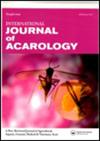毒死蜱对长角血蜱唾液腺蛋白表达及调控的影响
IF 1
3区 农林科学
Q3 ENTOMOLOGY
引用次数: 0
摘要
摘要本研究旨在探讨唾液腺的解毒和稳态功能,并寻找可能的蜱虫防治新药靶蛋白。不同浓度的毒死蜱处理半饱雌性长角血蜱,通过DIA定量蛋白质组学方法定量测定唾液腺中的所有蛋白质,并通过多种深度的生物信息学方法进行蛋白质分析和功能挖掘,解释唾液腺解毒功能的分子机制。来自5个正常组和8个不同治疗组的定量信息显示,共鉴定出3152种蛋白质。这些蛋白质的表达水平随着毒死蜱浓度和处理时间的不同而变化。但经过全面分析发现,毒死蜱作用后,参与解毒的谷胱甘肽S-转移酶和谷氨酰胺合成酶等蛋白质,参与应激的热休克蛋白,以及参与维持机体稳态的酸性鞘磷脂酶都发生了相应的变化。我们发现并解释了唾液腺的解毒、应激和稳态功能。对在这些功能中起关键作用的蛋白质的调控策略进行了探索。本文章由计算机程序翻译,如有差异,请以英文原文为准。
Effect of chlorpyrifos on the expression and regulation of salivary gland protein of Haemaphysalis longicornis
ABSTRACT The aim of this study is to explore the detoxification and homoeostasis functions of salivary glands, and to look for possible target proteins of new drugs for tick prevention and treatment. Different concentrations of chlorpyrifos to deal with the semi-engorged female Haemaphysalis longicornis, through the DIA quantitative proteomics method to quantitatively determine of all the proteins in the salivary glands, and through a variety of the depth of the bioinformatics methods for protein analysis and function mining, explain the molecular mechanism of detoxification function of salivary glands. Quantitative information from 5 normal groups and 8 different treatment groups showed that a total of 3152 proteins were identified. The expression levels of these proteins changed with the chlorpyrifos different concentration and treatment times. However, after the overall analysis, it was found that after the action of chlorpyrifos, the proteins involved in detoxification, such as glutathione S-transferase and glutamine synthetase, the heat shock proteins involved in stress, and the acid sphingomyelinase involved in maintaining the body’s homoeostasis had corresponding changes. We found and explained the functions of detoxification, stress, and homoeostasis of salivary glands. The regulatory strategies of proteins that played a key role in these functions were explored.
求助全文
通过发布文献求助,成功后即可免费获取论文全文。
去求助
来源期刊
CiteScore
2.20
自引率
9.10%
发文量
60
审稿时长
6-12 weeks
期刊介绍:
The International Journal of Acarology has a global readership and publishes original research and review papers on a wide variety of acarological subjects including:
• mite and tick behavior
• biochemistry
• biology
• control
• ecology
• evolution
• morphology
• physiology
• systematics
• taxonomy (single species descriptions are discouraged unless accompanied by additional new information on ecology, biology, systematics, etc.)
All submitted manuscripts are subject to initial appraisal by the Editor. If the English is not of a quality suitable for reviewers, the manuscript will be returned. If found suitable for further consideration, it will be submitted to peer review by independent, anonymous expert referees. All peer review is single blind.

 求助内容:
求助内容: 应助结果提醒方式:
应助结果提醒方式:


